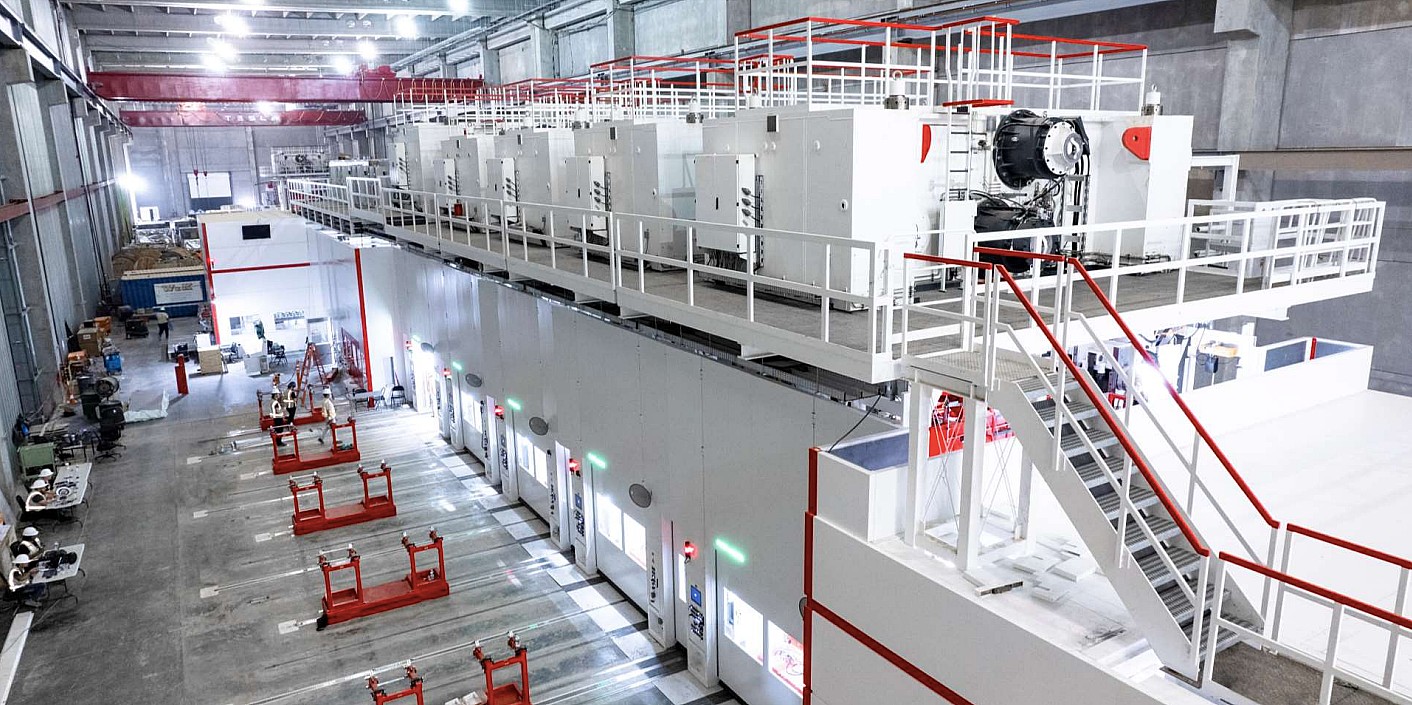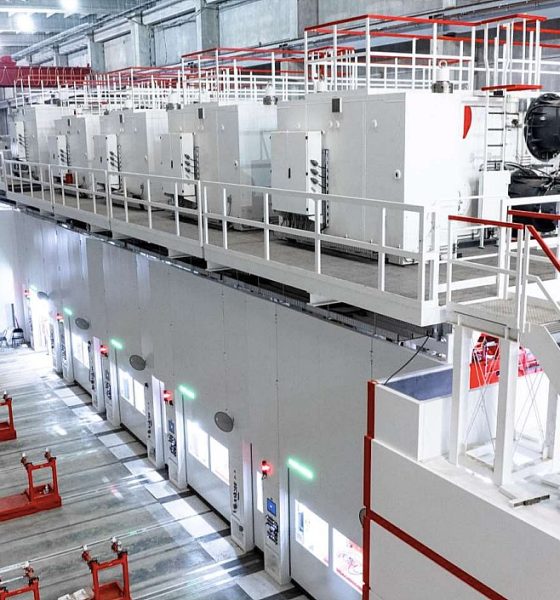

Investor's Corner
Jefferies raises Tesla (TSLA) price target to $950 over strong demand, growing capacity
Tesla stock (NASDAQ:TSLA) recently received an optimistic outlook from Jefferies Equity Research, with analyst Philippe Houchois raising his price target on the automaker from $850 to $950 per share. Jefferies cited several reasons behind its update on TSLA stock, though the analyst noted that part of it is due to the growing gap between Tesla and legacy OEMs.
“We raise EBIT estimates 7-9% for 2022-23 and PT to $950 on higher capacity ramp and sustained demand, following further analysis of Q3 data and various sources of information on the soon-to-be-launched Berlin facility. For some time, the narrative has been legacy OEMs closing the gap; we see little evidence as Tesla continues to challenge at multiple levels. We raise EBIT and margin estimates in contrast with doubts about earnings momentum across legacy OEMs,” Houchois wrote in a note.
The Jefferies analyst noted that the demand has so far been stable for Tesla, and the company’s production capacity is getting better too. With strong demand and an ability to produce more of its products, Tesla could cater to substantially more consumers in the near future. Houchois estimated that even with a linear ramp, the addition of Giga Berlin and Giga Texas should add at least 500k units of actual capacity in one year. The analyst also noted that considering China’s recent results, concerns about domestic demand in the world’s largest EV market might be overblown.
“We make minor changes to 2021 delivery estimates (910k), calculating production exit run-rate of 1.1m, and raise 2022-23 volume to 1.3-1.7m units. Modeling a linear ramp-up of production at the low end of guided 5-10k units/week for two similarly sized new facilities in Austin and Berlin, Tesla is set to add at least 500k units of actual capacity in one year to 1.6million and a solid 200-250k of actual units in 2022.
“The final details of Q3 also showed China domestic sales of 73.6k units, putting to rest concerns about domestic demand, while annualized Q3 output yields 530k, i.e., Shanghai running at more than full capacity. Ytd Tesla delivered slightly more units than produced despite a still “immature” production network with cross-continent shipping accounting for c.20% of total production. Localizing production should improve delivery timing and associated transit costs,” Houchois wrote.
Apart from these, the Jefferies analyst noted that based on the information it could gather from Giga Berlin, the plant seems to be heavily designed for simplicity. This should make it easier for the company to produce vehicles like the Made-in-Germany Model Y in a manner that is extremely cost-efficient and relatively simple. This, together with Tesla’s capability to weather the chip shortage crisis by adapting its products to what components are available, should allow the company to keep an edge against its peers.
“From the information we could gather on the new Berlin facility, we noted that plant design was heavily flow-driven while the aluminum casting of both front and rear underbodies may reduce by c.40% the number of body-in-white components and robots required for welding and assembly. In a global auto industry plagued by complexity, Tesla continues to reduce complexity and set new standards for simplicity of design and assembly.
“Whilst Tesla has not been immune to supply disruptions in the course of 2021, it has outperformed peers in sourcing semi-conductors. From discussions with a senior expert in semi-conductor sourcing and manufacturing, we understand this partly reflects Tesla in-sourcing chip design with an ability to effect rapid re-design and secure more direct sourcing than peers,” the Jefferies analyst wrote.
Disclaimer: I own TSLA stock.
The Teslarati team would appreciate hearing from you. If you have any tips, reach out to me at maria@teslarati.com or via Twitter @Writer_01001101.

Investor's Corner
Tesla stock closes at all-time high on heels of Robotaxi progress

Tesla stock (NASDAQ: TSLA) closed at an all-time high on Tuesday, jumping over 3 percent during the day and finishing at $489.88.
The price beats the previous record close, which was $479.86.
Shares have had a crazy year, dipping more than 40 percent from the start of the year. The stock then started to recover once again around late April, when its price started to climb back up from the low $200 level.
This week, Tesla started to climb toward its highest levels ever, as it was revealed on Sunday that the company was testing driverless Robotaxis in Austin. The spike in value pushed the company’s valuation to $1.63 trillion.
Tesla Robotaxi goes driverless as Musk confirms Safety Monitor removal testing
It is the seventh-most valuable company on the market currently, trailing Nvidia, Apple, Alphabet (Google), Microsoft, Amazon, and Meta.
Shares closed up $14.57 today, up over 3 percent.
The stock has gone through a lot this year, as previously mentioned. Shares tumbled in Q1 due to CEO Elon Musk’s involvement with the Department of Government Efficiency (DOGE), which pulled his attention away from his companies and left a major overhang on their valuations.
However, things started to rebound halfway through the year, and as the government started to phase out the $7,500 tax credit, demand spiked as consumers tried to take advantage of it.
Q3 deliveries were the highest in company history, and Tesla responded to the loss of the tax credit with the launch of the Model 3 and Model Y Standard.
Additionally, analysts have announced high expectations this week for the company on Wall Street as Robotaxi continues to be the focus. With autonomy within Tesla’s sights, things are moving in the direction of Robotaxi being a major catalyst for growth on the Street in the coming year.
Elon Musk
Tesla needs to come through on this one Robotaxi metric, analyst says
“We think the key focus from here will be how fast Tesla can scale driverless operations (including if Tesla’s approach to software/hardware allows it to scale significantly faster than competitors, as the company has argued), and on profitability.”

Tesla needs to come through on this one Robotaxi metric, Mark Delaney of Goldman Sachs says.
Tesla is in the process of rolling out its Robotaxi platform to areas outside of Austin and the California Bay Area. It has plans to launch in five additional cities, including Houston, Dallas, Miami, Las Vegas, and Phoenix.
However, the company’s expansion is not what the focus needs to be, according to Delaney. It’s the speed of deployment.
The analyst said:
“We think the key focus from here will be how fast Tesla can scale driverless operations (including if Tesla’s approach to software/hardware allows it to scale significantly faster than competitors, as the company has argued), and on profitability.”
Profitability will come as the Robotaxi fleet expands. Making that money will be dependent on when Tesla can initiate rides in more areas, giving more customers access to the program.
There are some additional things that the company needs to make happen ahead of the major Robotaxi expansion, one of those things is launching driverless rides in Austin, the first city in which it launched the program.
This week, Tesla started testing driverless Robotaxi rides in Austin, as two different Model Y units were spotted with no occupants, a huge step in the company’s plans for the ride-sharing platform.
Tesla Robotaxi goes driverless as Musk confirms Safety Monitor removal testing
CEO Elon Musk has been hoping to remove Safety Monitors from Robotaxis in Austin for several months, first mentioning the plan to have them out by the end of 2025 in September. He confirmed on Sunday that Tesla had officially removed vehicle occupants and started testing truly unsupervised rides.
Although Safety Monitors in Austin have been sitting in the passenger’s seat, they have still had the ability to override things in case of an emergency. After all, the ultimate goal was safety and avoiding any accidents or injuries.
Goldman Sachs reiterated its ‘Neutral’ rating and its $400 price target. Delaney said, “Tesla is making progress with its autonomous technology,” and recent developments make it evident that this is true.
Investor's Corner
Tesla gets bold Robotaxi prediction from Wall Street firm
Last week, Andrew Percoco took over Tesla analysis for Morgan Stanley from Adam Jonas, who covered the stock for years. Percoco seems to be less optimistic and bullish on Tesla shares, while still being fair and balanced in his analysis.

Tesla (NASDAQ: TSLA) received a bold Robotaxi prediction from Morgan Stanley, which anticipates a dramatic increase in the size of the company’s autonomous ride-hailing suite in the coming years.
Last week, Andrew Percoco took over Tesla analysis for Morgan Stanley from Adam Jonas, who covered the stock for years. Percoco seems to be less optimistic and bullish on Tesla shares, while still being fair and balanced in his analysis.
Percoco dug into the Robotaxi fleet and its expansion in the coming years in his latest note, released on Tuesday. The firm expects Tesla to increase the Robotaxi fleet size to 1,000 vehicles in 2026. However, that’s small-scale compared to what they expect from Tesla in a decade.
Tesla expands Robotaxi app access once again, this time on a global scale
By 2035, Morgan Stanley believes there will be one million Robotaxis on the road across multiple cities, a major jump and a considerable fleet size. We assume this means the fleet of vehicles Tesla will operate internally, and not including passenger-owned vehicles that could be added through software updates.
He also listed three specific catalysts that investors should pay attention to, as these will represent the company being on track to achieve its Robotaxi dreams:
- Opening Robotaxi to the public without a Safety Monitor. Timing is unclear, but it appears that Tesla is getting closer by the day.
- Improvement in safety metrics without the Safety Monitor. Tesla’s ability to improve its safety metrics as it scales miles driven without the Safety Monitor is imperative as it looks to scale in new states and cities in 2026.
- Cybercab start of production, targeted for April 2026. Tesla’s Cybercab is a purpose-built vehicle (no steering wheel or pedals, only two seats) that is expected to be produced through its state-of-the-art unboxed manufacturing process, offering further cost reductions and thus accelerating adoption over time.
Robotaxi stands to be one of Tesla’s most significant revenue contributors, especially as the company plans to continue expanding its ride-hailing service across the world in the coming years.
Its current deployment strategy is controlled and conservative to avoid any drastic and potentially program-ruining incidents.
So far, the program, which is active in Austin and the California Bay Area, has been widely successful.








